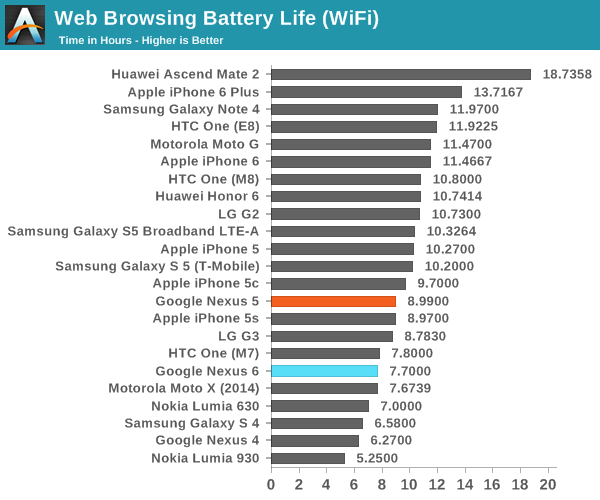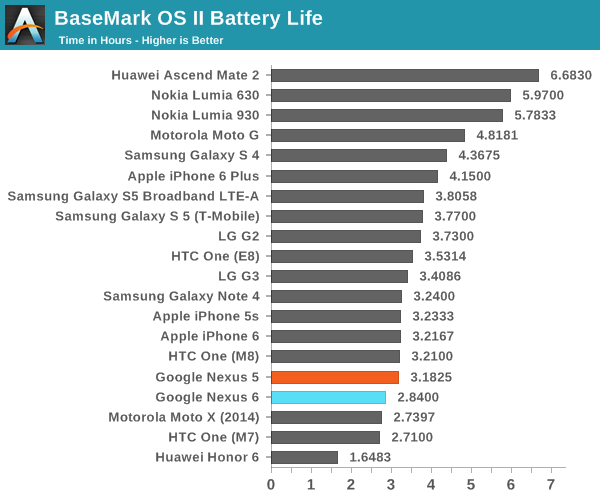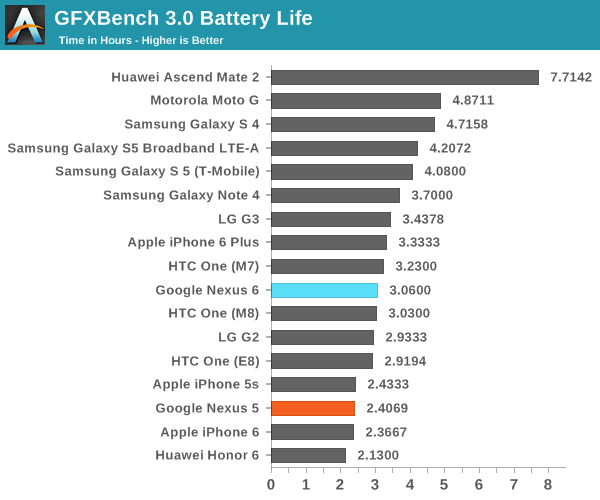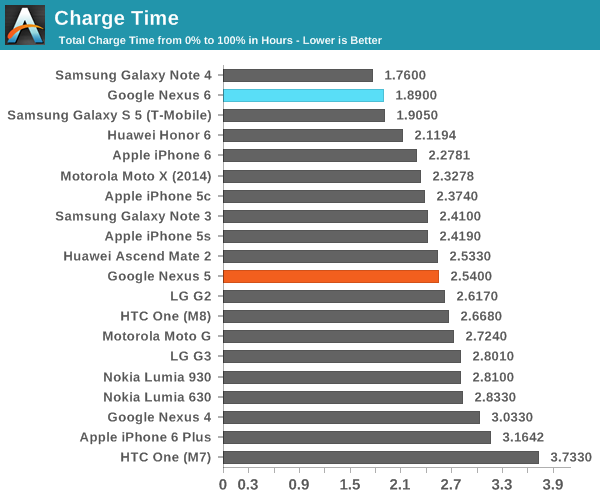The Nexus 6 Review
by Brandon Chester on November 12, 2014 1:00 PM ESTBattery Life
Battery life is one of the most important aspects of a smartphone, as it effectively determines how long you'll be able to use all of its other features. In order to get a comprehensive understanding of battery life on the Nexus 6 we run a variety of tests that attempt to stress different parts of the device in order to determine the battery performance in different conditions. Most important is that all displays are calibrated to 200 nits to avoid penalizing certain phones for having brighter displays than others.

The first test is our WiFi web browsing test which loads a set of web pages in a loop with pauses to avoid penalizing phones with faster SoCs than others. In this test we see that the Nexus 6 does perform somewhat poorly. Compared to Samsung's Galaxy Note 4 which has essentially the same specifications on paper, the Nexus 6 lasts 4.27 hours shorter. It is likely that this can be attributed to the display, which may not be as efficient as the latest and greatest AMOLED panel used in the Note 4.
At this point we would usually post results for web browsing battery life on LTE. However, I've had difficulty locating a place to perform testing with a reliable cellular signal, and I didn't wish to put the Nexus 6 at an unfair disadvantage by performing the test with poor reception. Because of this, I was unable to obtain LTE battery life results for the Nexus 6, but given the platform it's likely that battery life is around 7.25 to 7.5 hours on our LTE web test.


In our more SoC-bound BaseMark OS II battery test we see that the Nexus 6 doesn't last quite as long as the Note 4. This is again likely due to a higher display power consumption on the Nexus 6, as both devices share the same SoC fabricated on the same process. However, we see that the battery score is a bit higher, likely due to a higher average CPU frequency afforded by a larger heat dissipation area to reduce throttling.


With GFXBench which is a more GPU focused test, we see similar results to our BaseMark OS II test. The Nexus 6 doesn't last quite as long as the Galaxy Note 4, with slightly more than 3 hours of usage compared to the Note 4 with 3.7 hours of usage. The gap definitely closes between the two here, but unfortunately it seems that the display continues to hurt overall battery life. The fact that the web browsing result is so close here suggests that Motorola is continuing to target "24 hours of mixed usage", so if one does fit their usage model they shouldn't have isssues lasting a day on battery. I can't help but think that a good LCD would get them much more battery life for the same battery size, but it should be usable here even if it's behind the competition.
Charge Time
The charge time of a smartphone is also very important. While having a long battery life means that a device can be used for longer, if it also requires a very long charging time it may be that the device is less frequently able to be fully charged and thus unable to actually reach its potential battery life. Charge time can also be an important factor in time-constrained situations such as topping up your battery before a flight. In order to test battery life we deplete the device's battery charge to 0, and then measure the duration that the device is plugged in until it reaches a power draw that indicates it is completely charged.

The Nexus 6 includes Motorola's Turbo Charger which can output 9V at 1.6A or 12V at 1.2A to Qualcomm Quick Charge 2.0 compatible devices. As you can see above, this leads to an exceptionally low charge time of 1.89 hours. I'm very glad that Google and Motorola decided to include the Turbo Charger instead of a typical 5W adapter. Something I would like to note is that my Turbo Charger did exhibit very noticeable coil whine, although this may have simply been an issue specific to my unit.










136 Comments
View All Comments
tuxRoller - Wednesday, November 12, 2014 - link
Google really screwed up this years nexus devices.They are what I always buy, so now I'm left in a bit of a lurch.
Probably will wait for the 64bit transition next (snapdragon 810, or exynos 7, though I'd prefer to avoid img gpus).
hpglow - Wednesday, November 12, 2014 - link
I'm a little taken back by the poor battery life compared to the note 4. The screen is a little larger but damn.modulusshift - Wednesday, November 12, 2014 - link
Hey, can we please get a storage benchmark on this? Ars claims it has big problems, is that a memory supplier issue? Thank you!jaysns - Wednesday, November 12, 2014 - link
Apparently there is a huge performance hit when switching on encryption on the Nexus 5 http://www.reddit.com/r/nexus6/comments/2m4jra/une...Can only hope this is a bug as this will pretty dramatically affect how the device performs.
1032724311 - Wednesday, November 12, 2014 - link
系统还是原来是原生系统 可终端设备已经不是原来的nexus的味道了spikebike - Thursday, November 13, 2014 - link
So for twice the money (or so) of the nexus 5 we get a phone that loses many benchmarks (battery life, cpu, brightness, saturation) to the nexus 5. What's worse is that the nexus 5 was already trailing in battery life to begin with.Here's hoping google adopts some of the better phones into the GPE program.
Nevod - Thursday, November 13, 2014 - link
What seems to be most strange is the really poor battery life. Note 4 has just a bit smaller screen (10% difference only) yet more than 50% longer life. The cause isn't obvious, they both have AMOLED screens of same resolution, exactly same battery capacity and similar performance. The only differences are SoC (I get that it's the most important thing, but modern SoCs aren't that different in efficiency IIRC) and perhaps screen quality. When Galaxy Nexus came out, it had screen ahead of everyone else - but it was immature and extremely power hungry, paired with an already outdated SoC which GPU was overloaded with screen's resolution it had really poor battery life in browsing. Displays advanced and soon even screens with much smaller pitch were more efficient, processes shrank and GPUs consumed modest power on higher resolutions.Here, however, everything is nearly identical to Note 4. What is the cause of such a difference? Is the screen on N6 really is such a power hog (who's the supplier, anyway? Samsung, I suppose?). Though even the screen itself shouldn't be so problematic. Is the Exynos, and Mali in particular so much more efficient? Unlikely. I do think that this is caused by software, as seemingly it was with most Nexus phones - they were never really good at battery life. Even the Lollipop doesn't seem to help that.
darkich - Thursday, November 13, 2014 - link
Yeah,on top of all that, Lollipop is said to make HUGE power efficiency gains over KitKat.So this story is a major upset to some MYTHS.
What happened with pure, clean Android (supposedly more efficient), and the bloated, messy Samsung ROM (supposedly less efficient)?
If the myths are true, Note 4 with Lollipop should have ridiculously better efficiency than this, on basically equal hardware.
darkich - Thursday, November 13, 2014 - link
Oh and btw, the Samsung Note 4 ROM is vastly better than this.Besides offering the richest possible multitasking options, and all the S Pen extras, it actually makes one handed use easily possible.
This aspect keeps on getting ignored in the reviews just because reviewers arent even thinking about using it.
I ignored the one handed option too for months on my Note 3, but slowly it sank in, and now I see it as an essential piece of any proper phablet software.
Nevod - Thursday, November 13, 2014 - link
I've re-read battery and display parts of Nexus 6 and Note 4 reviews and now I think I do get it. Looks like Nexus 6 indeed has a problematic screen, like the Galaxy Nexus had before - it has way too high power consumption and low max brightness. However, that by itself shouldn't cause too much of a problem in real use (unless you are typically browsing in direct sunlight).Battery life test is done at 200 nits, almost the max of 250 nits for Nexus 6. GNex at that brightness level had some serious power consumption from display alone, well over 1 watt, so screen's power consumption dominates the test done like that. IRL, you don't just load the page over and over, with modest CPU and GPU load, you actually scroll a lot, seriously loading GPU - you actually scroll way more than you do anything else, so RL web browsing life is dominated by GPU power consumption, as the screen is usually running at low brightness level and it's contribution to power consumption isn't that big.
So, I suppose, while for sure Nexus 6 will have less battery life than Note 4 due to crappy screen tech, in real life, there shouldn't be too much of a difference, probably around 10%, 15% at most.